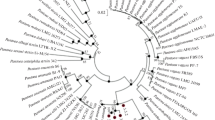Abstract
Esterase zymograms were obtained following polyacrylamide slab gel electrophoresis of protein extractsFusarium sambucinum and related species originating from different geographic locations and different matrices. The sites of esterase activity were recorded, and the Rfs were calculated. The data were used for the construction of phenograms by cluster analysis and nonlinear mapping by computerized classification techniques. The fifteen isolates ofF. sambucinum, the eight isolates ofF. torulosum and the six isolates ofF. spec. nov. each had identical profiles, and are therefore electrophoretically distinct species. The isolates ofF. sarcochroum, one ofF. sambucinum sensu lato (BBA 64280) and fifteen isolates ofF. sambucinum were electrophoretically indistinguishable from each other. We assume they are synonymous. The isolate ofF. bactridioides, one ofF. sambucinum sensu lato (BBA 64993) and eight isolates ofF. torulosum had uniform EST patterns, therefore the two species are electrophoretically identical. We assume they are also synonymous. The remaining three isolates ofF. sambucinum sensu lato are somewhat closely related toF. sambucinum isolates on the basis of our investigations.
Similar content being viewed by others
References
Nirenberg HI. Recent advances in taxonomy ofFusarium. Studies in Mycology 1990; 32: 91–101.
Crowhurst RN, Hawthorne BT, Rikkerink EHA, Templeton MD. Differentiation ofFusarium solani f. sp.cucurbitae races 1 and 2 by random amplification of polymorphic DNA. Current Genetics 1991; 20: 391–96.
Guadet J, Julien J, Lafay JF, Brygoo Y. Phylogeny of someFusarium species, as determined by large-subunit rRNA sequence comparison. Mol Biol Evol 1989; 6: 227–42.
Szécsi Á, Dobrovolszky A. Phylogenetic relationships amongFusarium measured by DNA reassociation. Mycopathologia 1985; 89: 89–94.
Kuninaga S, Yokosawa R. Genetic relatedness within and between formae speciales ofFusarium oxysporum as measured by DNA:DNA reassociation kinetics. Ann Phytopathol Soc Japan 1989; 55: 216–23.
Jakobson DJ, Gordon TR. Variability of mitochondrial DNA as an indicator of relationships between populations ofFusarium oxysporum f. sp.melonis. Mycol Res 1990; 94: 734–44.
Kistler HC, Momol EA, Benny U. Repetitive genomic sequences for determining relatedness among strains ofFusarium oxysporum. Phytopathology 1991; 81: 331–36.
Saito M, Ichinoi M, Tsuruta O. Usefulness of gel electrophoretic comparison of peroxidase for identification ofFusarium spp. Trans Mycol Soc Japan 1980; 21: 229–35 (in Japanese).
Szécsi Á, Hornok L. Genetic distance in fungus genusFusarium measured by comparative computer analysis of isoelectro-focusing esterase profiles. Acta Phytopathol Entomol Hung 1980; 21: 215–30.
Szécsi Á. Analysis of pectic enzymc zymograms ofFusarium species, I:Fusarium lateritium and related species. J. Phytopathol 1990; 128: 75–83.
Szécsi Á. Analysis of pectic enzyme zymograms ofFusarium species, II: Comparison of polygalacturonase zymograms ofFusarium culmorum andFusarium graminearum. J. Phytopathol 1990; 130: 188–96.
Hornok L. Serotaxonomy ofFusarium species of the sections Gibbosum and Discolor. Trans Br Mycol Soc 1980, 74: 73–78.
Nirenberg HI. Morphological differentiation ofFusarium sambucinum Funkel sensu stricto,F. torulosum (Berk. et Curt.) Nirenberg comb. nov. andF. venenatum Nirenberg sp. nov. Mycopathologia 1995; 129: 131–141 (this issue).
Staples RC, Stahmann MA. Changes in proteins and several enzymes in susceptible bean leaves after infection with bean rust fungus. Phytopathology 1964; 54: 760–64.
Layne E. Spectrophotometric and turbidimetric methods for measuring proteins. In: Methods in Enzymology, Vol 3. New York: Academic Press, 1975: 447–57.
Reddy MN, Stahmann MA. Isozyme patterns ofFusarium species and their significance in taxonomy. Phytopathol Z 1972; 74: 115–25.
Baertlein DA, Baertlein BA, McDaniel RG. PHYLO: A cluster analysis program. J Heredity 1990; 81: 87–88.
Sammon JW Jr. A nonlinear mapping for data structure analysis. IEEE Trans Computers 1969; C18: 401–407.
Szécsi Á, Szentkirályi F, Köves-Péchy CH. Comparison of esterase patterns ofFusarium culmorum andFusarium graminearum. Acta Phytopathol Acad Sci Hung 1976; 11: 183–203.
Pomázi A, Hornok L, Szécsi Á. Isoelectric focusing isozyme profiles and taxonomic distances amongFusarium species of the sections Arthrosporiella and Sporotrichiella. Acta Microbiol Hung 1993; 40: 71–79.
Bonde MR, Micales JA, Peterson GL. The use of isozyme analysis for identification of plant pathogenic fungi. Plant Disease 1993; 77: 961–68.
Micales JA, Bonde MR, Peterson GL. The use of isozyme analysis in fungal taxonomy and genetics. Mycotaxon 1986; 27: 405–49.
Petrunak DM, Christ BJ. Isozyme variability inAlternaria solani andA. alternata. Phytopathology 1992; 82: 1343–47.
Szécsi Á, Tóth S. Comparison of isolates in theChaetomium aureum species group by esterase isoenzyme analysis. Can J Bot 1987; 65: 198–201.
Author information
Authors and Affiliations
Rights and permissions
About this article
Cite this article
Szécsi, Á., Turóczi, G. & Bordás, B. Analysis of esterase zymograms ofFusarium sambucinum and related species. Mycopathologia 129, 165–171 (1995). https://doi.org/10.1007/BF01103342
Received:
Accepted:
Issue Date:
DOI: https://doi.org/10.1007/BF01103342




